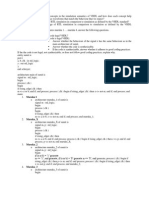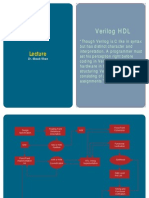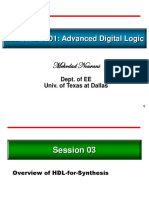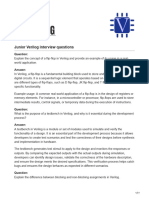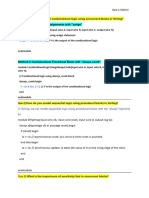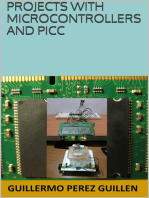0 ratings0% found this document useful (0 votes)
44 viewsIntroduction To Verilog Abstraction Levels (Theory) - FPGA & Embedded Systems Lab - Computer Science & Engineering - COE PUNE Virtual Lab
Introduction To Verilog Abstraction Levels (Theory) - FPGA & Embedded Systems Lab - Computer Science & Engineering - COE PUNE Virtual Lab
Uploaded by
deepakk_alpine,M
Copyright:
© All Rights Reserved
Available Formats
Download as PDF, TXT or read online from Scribd
Introduction To Verilog Abstraction Levels (Theory) - FPGA & Embedded Systems Lab - Computer Science & Engineering - COE PUNE Virtual Lab
Introduction To Verilog Abstraction Levels (Theory) - FPGA & Embedded Systems Lab - Computer Science & Engineering - COE PUNE Virtual Lab
Uploaded by
deepakk_alpine0 ratings0% found this document useful (0 votes)
44 views4 pages,M
Original Title
Introduction to Verilog Abstraction Levels (Theory) _ FPGA & Embedded Systems Lab _ Computer Science & Engineering _ COE PUNE Virtual Lab
Copyright
© © All Rights Reserved
Available Formats
PDF, TXT or read online from Scribd
Share this document
Did you find this document useful?
Is this content inappropriate?
,M
Copyright:
© All Rights Reserved
Available Formats
Download as PDF, TXT or read online from Scribd
Download as pdf or txt
0 ratings0% found this document useful (0 votes)
44 views4 pagesIntroduction To Verilog Abstraction Levels (Theory) - FPGA & Embedded Systems Lab - Computer Science & Engineering - COE PUNE Virtual Lab
Introduction To Verilog Abstraction Levels (Theory) - FPGA & Embedded Systems Lab - Computer Science & Engineering - COE PUNE Virtual Lab
Uploaded by
deepakk_alpine,M
Copyright:
© All Rights Reserved
Available Formats
Download as PDF, TXT or read online from Scribd
Download as pdf or txt
You are on page 1of 4
6/20/2014 Introduction to Verilog Abstraction Levels (Theory) : FPGA & Embedded Systems Lab : Computer Science & Engineering
: COE PUNE Virtual Lab
http://coep.vlab.co.in/?sub=29&brch=88&sim=1407&cnt=1 1/4
Search
. you are here->home->computer science & engineering->fpga & embedded systems lab->introduction to verilog abstraction levels .
.
Introduction to Verilog Abstraction Levels
.
.
Aim Pre Test Theory Procedure and Demo Simulation Post Test Reference People Feedback
Verilog HDL:
Verilog is both the structural and functional language. Internals of each module can be defined at five levels of abstraction, depending on the
need of the design. The module behaves identically with the external environment irrespectively of the level of abstraction at which the module is
described. Internals of the module are hidden from the environment. Thus, the level of abstraction to describe the module can be changed
without any change in the environment.
The levels are described below:
1. Switch (Transistor) Level
The lowest level of abstraction for a digital HDL would be the switch level, which refers to the ability to describe the circuit as a netlist of
transistor switches. A more detailed modeling scheme that can catch some additional electrical problems when transistors are used in this
way. Now, little-used because circuits generally arent built this way.
Switch Primitives:
Unidirectional Primitives Bidirectional Primitives
cmos nmos pmos pullup rcoms rnmos rpmos pulldown tran tranif0 tranif1 rtran rtranif0 rtranif1
Switch Instantiation:
Unidirectional Switchs Bidirectional Switchs
[r]nmos n1 (drain,source,gate);
[r]pmos p1 (drain,source,gate);
[r]cmos c1(drain, source, ngate, pgate) ;
[r]tran t1 (inout1,inout2);
[r]tranif0 t2 (data1, data2, control);
[r]tranif1 t3 (data1, data2, control);
Example 1: CMOS Inverter
module cmos_inv (In, Out); // module declaration
input In;
output Out;
supply1 vdd;
supply0 gnd;
pmos p1(Out, vdd, In); // pmos instantiation
nmos n1(Out, gnd, In); // nmoc instantiation
endmodule
Fig. CMOS Inverter Verilog code
2. Gate (Structural) Level
A slightly higher level of abstraction would be the gate level, which refers to the ability to describe the circuit as a netlist of primitive logic gates
and functions. The gates have one scalar output and multiple scalar inputs.
Gate Primitives:
Gate Type Description Instantiation Syntax
and N-input AND gate and a1(out,in1,in2) ;
nand N-input NAND gate nand a2(out,in1,in2) ;
or N-input OR gate or a3(out,in1,in2) ;
nor N-input NOR gate nor a4(out,in1,in2) ;
.....
Home Workshop People Feedback Forum Contact us Login
6/20/2014 Introduction to Verilog Abstraction Levels (Theory) : FPGA & Embedded Systems Lab : Computer Science & Engineering : COE PUNE Virtual Lab
http://coep.vlab.co.in/?sub=29&brch=88&sim=1407&cnt=1 2/4
nor N-input NOR gate nor a4(out,in1,in2) ;
xor N-input XOR gate xor x1(out,in1,in2) ;
xnor N-input XNOR gate xnor x2(out,in1,in2) ;
not 1-input NOT gate not g1 (out , in) ;
buf 1-input & N-output BUF gate buf b1_2 (out1,out2, in) ;
bufif1 1-input,1-output,1-control BUF gate bufif1 b0(out,in,control) ;
bufif0 1-input,1-output,1-control BUF gate bufif0 b1(out,in,control) ;
notif1 1-input,1-output,1-control NOT gate notif1 b2(out,in,control) ;
notif0 1-input,1-output,1-control NOT gate notif0 b3(out,in,control) ;
Example 2: 2-1 Multiplexer
We will design 2-1 Multiplexer with one select signal. S0 is a selected signal wire. The I/O diagram and truth table for the Multiplexer are
shown below.
module mux2_1 (o1,in1,in2,S0); //module
output o1;
input in1,in2,S0;
and a1 (Q, in1, S0); //and instantiation
not n1 (P,S0); // not instantiation
and a2 (R, in2, P); // and instantiation
or o1 (o1, Q, R); // or instantiation
endmodule
Fig. Multiplexer 2:1 Verilog Code
3. Data Flow Level
For small circuits, the gate level modeling approach works very well because the number of gates is limited and designer can instantiate and
connects every gate individually. However in complex design the number of gates is very large. Thus implementing the function at a level higher
than gate level is good choice. Dataflow modeling has become a popular design approach as logic synthesis tools have become sophisticated.
This approach allows the designer to concentrate on optimizing the circuit in terms of data flow.
I. Continuous Assignments:
It is the most basic statement in dateflow level, used to drive a value onto a net. It replaces gates in the description of the circuit and describes
the circuit at a higher level of abstraction.
A continuous assignment statement starts with the keyword assign.
Syntax : assign [ delay ] net = expression;
Example : assign sum = a ^ b;
II. Implicit Continuous Assignment:
Instead of declaring a net and then writing a continuous assignment on the net. Verilog provides a shortcut by which a continuous assignment
can be placed on a net when it is declared. There can be only one implicit declaration assignment per net because a net is declared only once.
Example: wire out= in1 & in2;
Example 3: 2-4 Line Decoder
module deco2_4 (EN, A0, A1, D0, D1, D2, D3);//module
input EN, A0, A1;
output D0, D1, D2, D3;
assign D0 =(EN & ~A1 & ~A0);
assign D1 =(EN & ~A1 & A0);
assign D2 =(EN & A1 & ~A0);
assign D3 =(EN & A1 & A0);
endmodule
Fig. Line Decoder (2-4) Verilog Code
4. Functional and Algorithmic Level (Behavioral Modeling)
..... .....
6/20/2014 Introduction to Verilog Abstraction Levels (Theory) : FPGA & Embedded Systems Lab : Computer Science & Engineering : COE PUNE Virtual Lab
http://coep.vlab.co.in/?sub=29&brch=88&sim=1407&cnt=1 3/4
Verilog provides the designer the ability to describe the design functionality in an algorithmic manner. In other words the designer describes the
behavior of the circuit. The abstraction in this modeling is as simple as writing the logic in C language. Verilog behavioral models contain
procedural statements that control the simulation and manipulate variables of the data types previously described. The activity starts at the
control constructs initial and always. Each initial statement and each always statement starts a separate activity flow. All of the activity flows are
concurrent, allowing the user to model the inherent concurrence of hardware.
Procedural assignments:
Procedural assignments are used for updating reg, integer, time, real, realtime, and memory data types.
The left hand side of a procedural assignment could be:
reg, integer, real, realtime, or time data type.
Bit-select of a reg, integer, or time data type, rest of the bits are untouched
Part-select of a reg, integer, or time data type, rest of the bits are untouched.
Memory word.
Syntax: wire out= in1 & in2;
I. Blocking assignments:
Blocking assignment statements are executed in the order they are specified in a sequential block.
Example: initial
begin
a = 1 ;
b = #35 ;
end
II. Non-blocking assignments:
The nonblocking assignment allows assignment scheduling without blocking the procedural flow.
Syntax: initial
begin
a<=1 ;
b<= # 35 ;
end
Conditional (if-else) statement:
The condition (if-else) statement is used to make a decision whether a statement is executed or not. The keywords if and else are used to
make conditional statement.
Syntax: if (condition_1)
statement 1;
else if (condition_2)
begin
statement 2;
end
else
statement 3;
Case statement:
The case statement is a multi-way decision statement that tests whether an expression matches one of the expressions and branches
accordingly. Keywords case and endcase are used to make a case statement. The case statement syntax is as follows.
Syntax: case (expression)
case 1: statement_1;
case 2: statement_2;
case 3: statement_3;
default: default_statement;
endcase
Loop statement:
There are four types of looping statements in Verilog:
for loop
while
forever
Repeat
Syntax:
for loop while loop forever loop Repeat loop
initial
begin
a = 20;
for (i =1;
i<25;i=i+1)
begin
a=a+1;
end
initial
begin
a = 20;
i = 0;
while (i <
a)
begin
i = i +
1;
a = a -
1;
end
initial
begin
clk = 0;
forever #5 clk =
~clk;
end
initial
begin
x = 0;
repeat( 16 )
begin
#2 $display("y=
", y);
x = x + 1;
end
Example 4: 8-bit Binary Counter
6/20/2014 Introduction to Verilog Abstraction Levels (Theory) : FPGA & Embedded Systems Lab : Computer Science & Engineering : COE PUNE Virtual Lab
http://coep.vlab.co.in/?sub=29&brch=88&sim=1407&cnt=1 4/4
module half_add (S, C, A, B);
input A, B;
output S, C;
reg S, C;
always @ (A or B)
begin
S = A ^B;
C = A & B;
end
Fig. Binary counter(8-bit) Verilog Code
5. Register transfer Level (RTL Modelling)
Describes a system by the flow of data and controls signals within and between functional blocks. It's a behavioral design concept in which you
make HDL models of registered circuits and how signals interact between them such as memories, flip flops, latches, shift registers, and so
on. RTL is a combination of Behavioral and Data flow modeling which should be synthesizable. RTL description is more complex and less
technology dependent than behavior hardware description.
Example 5: 2-1 Multiplexer
module mux2to1 (in1,in2, S0, o1);
input in1,in2,S0;
output o1;
always_comb begin
case (sel)
1b0 :o1 = in1;
1b1 : o1 = in2;
default : o1 = 1bx;
endcase
end
Fig. Multiplexer 2:1 Verilog Code
Copyright @ 2014 Under the NME ICT initiative of MHRD (Licensing Terms)
Powered by Amrita Virtual Lab Collaborative Platform [ Ver 00.3.2 ]
You might also like
- VHDL Interview Question(s)Document8 pagesVHDL Interview Question(s)Sudheer AcharyaNo ratings yet
- VLSI Interview QuestionsDocument7 pagesVLSI Interview QuestionsVlsi GuruNo ratings yet
- DFT With Tetramax PDFDocument33 pagesDFT With Tetramax PDFdeepakk_alpine100% (1)
- Tutorial BTC RecoverDocument17 pagesTutorial BTC RecoverWahyu Nur100% (2)
- NDIFOR - Internship Report DraftDocument77 pagesNDIFOR - Internship Report Draftnestor martourezNo ratings yet
- Blood GroupDocument1 pageBlood GroupgpsriramNo ratings yet
- Verilog HDL: Dr. Shoab KhanDocument61 pagesVerilog HDL: Dr. Shoab KhanSufyan AsgharNo ratings yet
- 2) Difference Between Blocking and Non-Blocking? (Verilog Interview Questions That Is MostDocument39 pages2) Difference Between Blocking and Non-Blocking? (Verilog Interview Questions That Is MostRAGUL RAJ SNo ratings yet
- Vlsi Unit 5 NotesDocument21 pagesVlsi Unit 5 NotesRamana Sekar100% (1)
- ECE 451 Verilog Exercises Sept 14, 2007 James Barnes (James - Barnes@colostate - Edu)Document14 pagesECE 451 Verilog Exercises Sept 14, 2007 James Barnes (James - Barnes@colostate - Edu)Sreekanth PagadapalliNo ratings yet
- Verilog Calculator Matrix MultiplicationDocument8 pagesVerilog Calculator Matrix MultiplicationRadhey Shyam YadavNo ratings yet
- You Could Download File D - FF.VDocument133 pagesYou Could Download File D - FF.VPradeep BabuNo ratings yet
- Chapter1: Introduction To VerilogDocument15 pagesChapter1: Introduction To Verilogarunguptha_gsNo ratings yet
- Digital System Design Introduction To Verilog: SajidDocument26 pagesDigital System Design Introduction To Verilog: SajidmuzammiliqbalNo ratings yet
- Day1 and 2Document48 pagesDay1 and 2Effecure HealthcareNo ratings yet
- Verilog TutDocument21 pagesVerilog TutNishana KumarNo ratings yet
- Lab 4 Verilog Gate Level ModellingDocument11 pagesLab 4 Verilog Gate Level Modellingsafdarmunir070No ratings yet
- Digital Design Lab Manual: Introduction To VerilogDocument48 pagesDigital Design Lab Manual: Introduction To VerilogKeith FernandesNo ratings yet
- VHDL RTL Synthesis BasicsDocument59 pagesVHDL RTL Synthesis Basicsnileshchhajed100% (2)
- 3.HDL Modeling 2Document44 pages3.HDL Modeling 2Himanshu PatraNo ratings yet
- Verilog HDL Interview Questions 1703504367Document21 pagesVerilog HDL Interview Questions 1703504367jainb8993No ratings yet
- Interview Questions About VerilogDocument14 pagesInterview Questions About VerilogKiran ReddyNo ratings yet
- DSD ReportDocument14 pagesDSD Report22051774No ratings yet
- DSD PPT Usr and CN and Odd DividerDocument22 pagesDSD PPT Usr and CN and Odd Dividerece19637ec003No ratings yet
- EEE248 CNG232 Lab Manual Spring2013Document40 pagesEEE248 CNG232 Lab Manual Spring2013Ibrahim AladoğanNo ratings yet
- (System) Verilog Tutorial: Aleksandar MilenkovićDocument56 pages(System) Verilog Tutorial: Aleksandar MilenkovićAbhinav TallapallyNo ratings yet
- DIGITAL SYSTEM DESIGN Manual1Document20 pagesDIGITAL SYSTEM DESIGN Manual1Muhammad shehr yarNo ratings yet
- Verilog - Q&ADocument24 pagesVerilog - Q&A6055 - Ragul TNo ratings yet
- DVCon Europe 2015 TA5 1 PaperDocument7 pagesDVCon Europe 2015 TA5 1 PaperJon DCNo ratings yet
- Verilog HDLDocument62 pagesVerilog HDLc406400100% (1)
- Synthesizable VHDL Slides AyonDocument39 pagesSynthesizable VHDL Slides AyonSreeja DasNo ratings yet
- Verilog BriefDocument12 pagesVerilog BriefShashin KunasegaranNo ratings yet
- Verilog Interview QuestionsDocument7 pagesVerilog Interview QuestionsVishal K SrivastavaNo ratings yet
- Verilog Hardware Description Language (HDL) : Why Use A HDLDocument16 pagesVerilog Hardware Description Language (HDL) : Why Use A HDLkeyurNo ratings yet
- Introduction To VHDL: by BODDU LokeshDocument22 pagesIntroduction To VHDL: by BODDU LokeshKiran GunasegaranNo ratings yet
- VlogDocument14 pagesVlogUday KumarNo ratings yet
- How To Write FSM Is VerilogDocument8 pagesHow To Write FSM Is VerilogAyaz MohammedNo ratings yet
- Verilog Assign StatementDocument7 pagesVerilog Assign StatementrwgadqhjfNo ratings yet
- Single Precision Floating Point UnitDocument45 pagesSingle Precision Floating Point UnitSumeet SauravNo ratings yet
- Assign in VerilogDocument4 pagesAssign in VerilogafmohfwhlNo ratings yet
- DCS-2 Practical File Part-1Document26 pagesDCS-2 Practical File Part-1ykr007No ratings yet
- Identifier: Identifier Are The Names Used To Give For An Object (Such As Signal NameDocument6 pagesIdentifier: Identifier Are The Names Used To Give For An Object (Such As Signal NameAurongo NasirNo ratings yet
- Introduction To Verilog AssignmentsDocument19 pagesIntroduction To Verilog AssignmentsEng'r Safeer AnsarNo ratings yet
- Drill 1Document10 pagesDrill 1kage mushaNo ratings yet
- Assign VerilogDocument4 pagesAssign Verilogafefhrbdf100% (1)
- Lab 07Document10 pagesLab 07api-241454978No ratings yet
- Verilog For PrintDocument15 pagesVerilog For PrintrppvchNo ratings yet
- Adobe Scan 23 Nov 2023Document11 pagesAdobe Scan 23 Nov 2023Hanisha SelviNo ratings yet
- Unit-3 Data Flow Level & Switch Level Modeling: Digital Design Through VerilogDocument14 pagesUnit-3 Data Flow Level & Switch Level Modeling: Digital Design Through VerilogSrinivas NaiduNo ratings yet
- Verilog Theory Interview QDocument29 pagesVerilog Theory Interview QchoradiyaankitaNo ratings yet
- Procedural and Concurrent Blocks in Verilog 1706091941Document15 pagesProcedural and Concurrent Blocks in Verilog 1706091941Purna satya srinivas VempalaNo ratings yet
- Verilog Lecture 3 - NoopurDocument64 pagesVerilog Lecture 3 - NoopurMonis KhanNo ratings yet
- VerilogDocument80 pagesVeriloggenx142No ratings yet
- Verilog Tutorial For BeginnersDocument4 pagesVerilog Tutorial For BeginnersNovelyn RabinoNo ratings yet
- Verilog Prep MaterialDocument11 pagesVerilog Prep MaterialSangeetha BajanthriNo ratings yet
- 4-8 MarchDocument15 pages4-8 Marchadyadesai7No ratings yet
- Birla Institute of Technology & Science, Pilani Lab Sheet - 1Document7 pagesBirla Institute of Technology & Science, Pilani Lab Sheet - 1SATYAVRAT SHARMANo ratings yet
- Projects With Microcontrollers And PICCFrom EverandProjects With Microcontrollers And PICCRating: 5 out of 5 stars5/5 (1)
- Arduino Measurements in Science: Advanced Techniques and Data ProjectsFrom EverandArduino Measurements in Science: Advanced Techniques and Data ProjectsNo ratings yet
- WAN TECHNOLOGY FRAME-RELAY: An Expert's Handbook of Navigating Frame Relay NetworksFrom EverandWAN TECHNOLOGY FRAME-RELAY: An Expert's Handbook of Navigating Frame Relay NetworksNo ratings yet
- BE EXPERT IN JAVA Part- 2: Learn Java programming and become expertFrom EverandBE EXPERT IN JAVA Part- 2: Learn Java programming and become expertNo ratings yet
- Practical Reverse Engineering: x86, x64, ARM, Windows Kernel, Reversing Tools, and ObfuscationFrom EverandPractical Reverse Engineering: x86, x64, ARM, Windows Kernel, Reversing Tools, and ObfuscationNo ratings yet
- Interview SeriesDocument5 pagesInterview Seriesdeepakk_alpineNo ratings yet
- Nuioaurur - TT: L. .1"i"i"t'Document4 pagesNuioaurur - TT: L. .1"i"i"t'deepakk_alpineNo ratings yet
- Boolean AlgebraDocument9 pagesBoolean Algebradeepakk_alpineNo ratings yet
- Madhuri ResumeDocument4 pagesMadhuri Resumedeepakk_alpineNo ratings yet
- Strategies For Low Power Consumption in VlsiDocument1 pageStrategies For Low Power Consumption in Vlsideepakk_alpineNo ratings yet
- Basic Shell Scripting: Semi Design "World Inside Semiconductor"Document2 pagesBasic Shell Scripting: Semi Design "World Inside Semiconductor"deepakk_alpineNo ratings yet
- ZTPI210Document1 pageZTPI210deepakk_alpineNo ratings yet
- CBSE - Application From Private CandidatesDocument2 pagesCBSE - Application From Private Candidatesdeepakk_alpineNo ratings yet
- Practical Brief (योगा क संि) : Print (ि ंट कर)Document1 pagePractical Brief (योगा क संि) : Print (ि ंट कर)deepakk_alpineNo ratings yet
- Students Participation Details For Games in I.T.S Engineering College 23 To 25 Jan 2018Document1 pageStudents Participation Details For Games in I.T.S Engineering College 23 To 25 Jan 2018deepakk_alpineNo ratings yet
- Cover LetterDocument1 pageCover Letterdeepakk_alpineNo ratings yet
- MacDocument20 pagesMacdeepakk_alpineNo ratings yet
- Semidesign "World Inside Semiconductor"Document2 pagesSemidesign "World Inside Semiconductor"deepakk_alpineNo ratings yet
- Research & Simulation - Network Simulations and Installation of NS2 and NS3Document2 pagesResearch & Simulation - Network Simulations and Installation of NS2 and NS3deepakk_alpineNo ratings yet
- Tools - i-MOSDocument2 pagesTools - i-MOSdeepakk_alpineNo ratings yet
- 1) Run The Convert Command (In Our Case We Ran It On Source)Document31 pages1) Run The Convert Command (In Our Case We Ran It On Source)sachinappsdbaNo ratings yet
- VG4D PartsDocument43 pagesVG4D Partsdschwab87No ratings yet
- SSD Buying Guide ListDocument19 pagesSSD Buying Guide ListyignaroknoNo ratings yet
- ATC - ATSC4 Traffic ControllerDocument4 pagesATC - ATSC4 Traffic ControllerJosé MauroNo ratings yet
- Speaker L Acoustic Dv-Dosc KitsDocument2 pagesSpeaker L Acoustic Dv-Dosc KitsagusmitrasysNo ratings yet
- Evolution, Challenge, and Outlook of TSV 3D IC - ICEP April 2011 KeynoteDocument16 pagesEvolution, Challenge, and Outlook of TSV 3D IC - ICEP April 2011 Keynoteice_speed2006No ratings yet
- Design and Implementation of 600va Ups Based 0n 89c51Document5 pagesDesign and Implementation of 600va Ups Based 0n 89c51setsindiaNo ratings yet
- Partition Entries (LBA 2-33)Document2 pagesPartition Entries (LBA 2-33)scribdbookdlNo ratings yet
- Exception HandlingDocument34 pagesException HandlingSheeba DhuruvarajNo ratings yet
- Pearl RBM 20 Module OwnersManualDocument44 pagesPearl RBM 20 Module OwnersManualAnonymous cdQSIU03AQNo ratings yet
- LIVE TEch Training InstituteDocument3 pagesLIVE TEch Training InstituteJohncena RockyNo ratings yet
- AVR 133: Long Delay Generation Using The AVR MicrocontrollerDocument8 pagesAVR 133: Long Delay Generation Using The AVR MicrocontrollernicoletabytaxNo ratings yet
- Selection SortDocument6 pagesSelection SortSherdilNo ratings yet
- PMS 7sd600 enDocument20 pagesPMS 7sd600 enmaheshNo ratings yet
- SATELLITE 2100CDS/CDT Product SpecificationsDocument4 pagesSATELLITE 2100CDS/CDT Product Specificationsmemo velascoNo ratings yet
- Operation Manual: (Wheel Balancer)Document13 pagesOperation Manual: (Wheel Balancer)hector castellanos rNo ratings yet
- Art Cam 2009 Jewel Smith UserGuide ItDocument403 pagesArt Cam 2009 Jewel Smith UserGuide ItDonato VellecaNo ratings yet
- Morin Actuator-79S 79B 79C HPDocument8 pagesMorin Actuator-79S 79B 79C HPInamex-fpVeracruzNo ratings yet
- ZR38650Document66 pagesZR38650BaCresNo ratings yet
- Embedded System - Unit 5Document3 pagesEmbedded System - Unit 5Padmasri GirirajanNo ratings yet
- Drill and BlastDocument72 pagesDrill and BlastSlamet Karta Negara100% (2)
- How Do I Configure My Newly Bought D-Link DSL-2730u Wireless N 150 ADSL2+ 4-Port Router (Cum Modem) - Airtel Broadband PDFDocument7 pagesHow Do I Configure My Newly Bought D-Link DSL-2730u Wireless N 150 ADSL2+ 4-Port Router (Cum Modem) - Airtel Broadband PDFSuresh Babu BonthuNo ratings yet
- Log20211113 205404Document23 pagesLog20211113 205404stopusingscribdNo ratings yet
- M4100 WebDocument2 pagesM4100 WebThiagoPinheiroNo ratings yet
- DPX - E140: FeaturesDocument2 pagesDPX - E140: FeaturesMaggie AEWINNo ratings yet
- PIC16F87XA Rev. B7 Silicon/Data Sheet ErrataDocument6 pagesPIC16F87XA Rev. B7 Silicon/Data Sheet ErrataSilviu CeausuNo ratings yet
- Trainingcourses 2012 enDocument8 pagesTrainingcourses 2012 enSudhakar VarmaNo ratings yet
